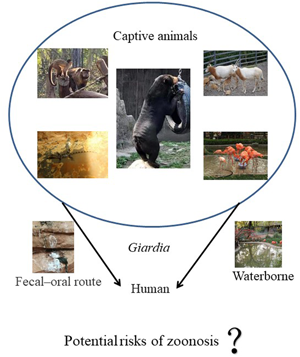Published online by Cambridge University Press: 08 June 2021

Giardia duodenalis is a common zoonotic intestinal pathogen. It has been increasingly reported in humans and animals; however, genotyping information for G. duodenalis in captive animals is still limited. This study was conducted to assess the prevalence and multilocus genotyping of G. duodenalis in captive animals in zoological gardens in Shanghai, China. A total of 678 fresh fecal samples were randomly collected from captive animals including non-human primates (NHPs) (n = 190), herbivores (n = 190), carnivores (n = 151), birds (n = 138) and reptiles (n = 9) in a zoo and were examined for the presence of G. duodenalis using nested polymerase chain reaction (nested PCR). All G. duodenalis positive samples were assayed with PCR followed by sequencing at β-giardin (bg), glutamate dehydrogenase (gdh) and triose phosphate isomerase (tpi) genes. In this study, 42 specimens (6.2%) were tested G. duodenalis-positive of the 678 fecal samples examined based on a single locus. A total of 30 (4.4%), 30 (4.4%) and 22 (3.2%) specimens were successfully amplified and sequenced at gdh, tpi and bg loci, respectively. Assemblages A and B were identified with assemblage B dominating in NHPs. Sequence analysis demonstrated that one, two and five new isolates were identified at bg, gdh and tpi loci. DNA sequences and new assemblage-subtypes of zoonotic G. duodenalis assemblages A and B were identified in the current study. Our data indicate the occurrence and molecular diversity of G. duodenalis and the potential zoonotic transmission in captive animals in China.
These authors contributed equally to this work.